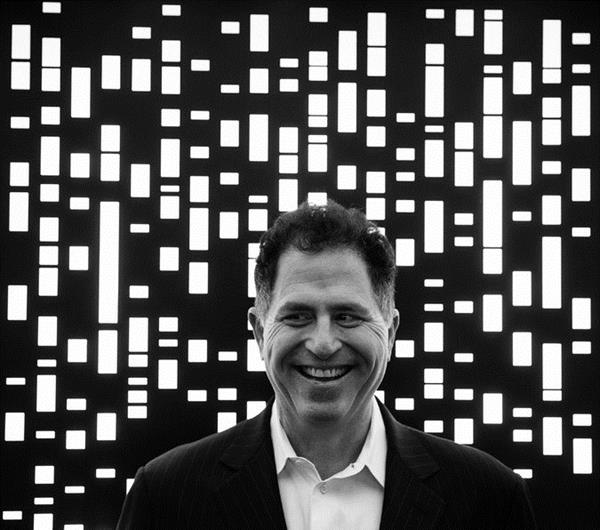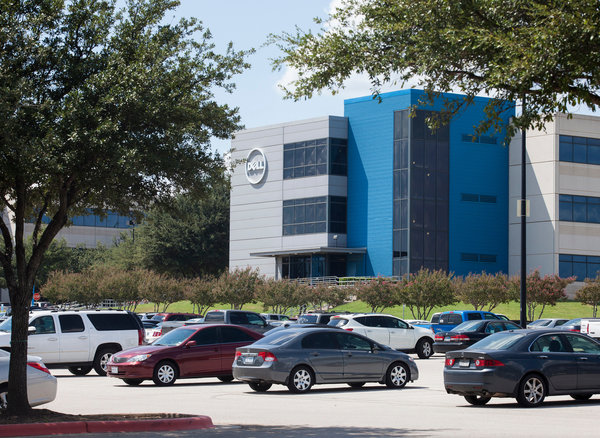|

Technology
Dell’s Life After Wall Street
By
QUENTIN HARDY
NOV. 2, 2014
|

On Tuesday,
Michael Dell will present his company’s plan for its
shareholder-free future.
Credit Damon Winter/The New York Times |
A year
after
spending $24.9 billion taking his
computer company private,
Michael S. Dell is gleeful to
have his namesake firm to himself. And to be done with Wall Street.
“This
morning on the treadmill I was watching Bloomberg and CNBC, all the
circus clowns,” Mr.
Dell said in a recent interview.
His disdain for investment advice as entertainment is obvious — so
obvious that no one should have been surprised that to get away from
Wall Street’s influence, Mr. Dell endured a monthslong, often personal
campaign for a higher shareholder buyout price by the corporate raider
Carl C. Icahn.
On
Tuesday, Mr. Dell will show what he has been up to since the
seven-month struggle with Mr. Icahn ended last year. At a coming-out
party in Austin, Tex., for the new Dell, Mr. Dell will try to persuade
people that his company is about far more than the personal computers
and computer servers it has been known for, with products intended for
things as varied as the cloud computing networks of global enterprises
and handy personal devices.
|

Mr. Dell, who
founded his company at 18, says its current expansion beyond its
core business, personal computers, began six years ago.
Credit Tony Avelar/Associated Press Images for Dell
|
|
It is
a transformation Mr. Dell says he actually started six years ago,
spending $18 billion on 40 acquisitions, infuriating investors like
Mr. Icahn and confounding industry analysts along the way.
In a
conference room high above Columbus Circle in Manhattan, Mr. Dell
recently provided the first extensive look inside his new plans for
his company, explaining the many pieces that add up to a new Dell and
reflecting on his tussle with Mr. Icahn, whom he calls “the great
Icahn,” in tones sarcastic even for a wealthy Texan. It is clear the
fight has not been forgotten.
When
Mr. Dell first proposed taking his company private, Dell was
handicapped by declining computer prices and backbreaking failure to
get into hot markets like mobile computing. The only way to fix it,
Mr. Dell argued, was to buy out investors and go private so he could
stop worrying about profit for a few quarters and remake the business.
The
biggest roadblock was Mr. Icahn’s demand for a higher price for his
shares. After many shareholder votes and court challenges, Mr. Dell
and his partners at the private equity firm Silver Lake raised their
offer by a few pennies. But Mr. Icahn did not exactly bless the
transaction.
“I
intend to call him to wish him good luck (he may need it),” Mr. Icahn
wrote in a letter to shareholders as he gave up the fight. A call to
Mr. Icahn was not returned.
Mr.
Dell founded the company when he was just 18, assembling and selling
personal computers from his college dorm, and he took it public at 23.
Now, at 49, he wears a pinstripe suit but no tie, has some gray at the
temples and rises excitedly to draw elementary diagrams that forecast
his profitability and the competition’s demise. You can own 75 percent
of the world’s third-biggest PC company, it seems, and still delight
in simple vindication.
“I
think he’s having the time of his life,” said Aaron Levie, co-founder
and chief executive of Box, an online data storage and collaboration
company, who has known Mr. Dell for two years. “He has control, and a
lot of assets that people don’t understand yet.”
Dell
has a comprehensive strategy at a time when peers like Hewlett-Packard
and IBM are splitting apart and selling bits of themselves.
The
new Dell has software, equipment for data storage and computer
networking, services and sensors. It is developing software that
measures facial expressions, voice tone, even how we individually
swipe key cards. There is a device that can make a hotel room’s
digital television into a secure corporate computer. A Dell tablet is
the world’s thinnest and lightest, the company says, with a
four-million-pixel screen and a three-dimensional camera. And, of
course, there are lots of new personal computers.
But
some things have not changed. Dell is using the same plan in software
and services that it used with PCs and servers two decades ago: Come
in with a lower-profit-margin, “good enough” version of something like
networking, then make the cheap stuff better.
“It
works,” Mr. Dell said. “You start out not as good, not as fast, and a
year or two later it’s faster and better and you can’t do stuff unless
you’re in it.”

The Dell campus in
Round Rock, Tex.
Credit Ben Sklar for The New York Times |
Undercutting the competition on prices is usually effective. But will
the big reboot of Dell work? Toni Sacconaghi, a financial analyst for
Sanford C. Bernstein, said Dell’s strategy will hold up as long as PCs
sell well. Being private, Dell does not have to disclose much about
sales and profits, but there are indications that Dell is getting the
cash from PCs to finance its transformation.
According to IDC, a tech-industry analysis firm, in the third quarter
of this year Dell shipped 10.4 million computers worldwide, a 9.7
percent increase from a year earlier. In the lucrative United States
market, Dell’s shipments increased 19.7 percent, to make up 24 percent
of the total market for PCs. HP, the top supplier of PCs to the United
States, had a 27.7 percent share, but grew 8.3 percent.
PC
sales throw off enough cash that in the first half of this year Dell’s
buyers paid off $2.4 billion of the $18 billion in debt that they took
out to make the purchase. The question is: Can Dell ignite sales
enough to become less reliant on the same old business?
For
Mr. Dell’s plan to work, his company has to get bigger and become
better at alliances. Dell has announced deals with Red Hat, a maker of
open-source software, regarding building cloud computing systems. His
networking equipment also relies on open source. There is a
Dell-Microsoft partnership, to sell Microsoft’s proprietary Azure
cloud computing software on Dell boxes.
A deal
with Oracle sells Oracle’s powerful database applications on Dell
machines to small and midsize companies, long a Dell stronghold. Dell
is working with industrial companies like John Deere and Boeing to
develop algorithms for precision farming and cloud computing systems
for aerospace research. In India, Dell has been putting chips in the
ears of cows to better manage livestock.
As a
private firm, its deals move faster — exactly what Mr. Dell wanted.
Last March, Dell bought Statsoft, a Tulsa, Okla., maker of predictive
analytic software. John A. Swainson, the head of software at Dell,
said it took two meetings with Mr. Dell lasting a total of two hours
and 15 minutes. “In a public company, there would be at least one
board meeting about this, maybe two, so that would be two quarters,”
he said.
That’s
not to say this transition has been easy. Dell had about 110,000
employees when it went private and is now estimated to have around
90,000. It is unclear how many more cuts there will be.
“They
need to revive themselves from the inside out,” said Matt Eastwood, an
executive director at IDC. “Twenty to 30 percent of the people inside
haven’t converted from the old ways. They probably won’t survive.”
Now
that Dell is stepping back into the spotlight, Mr. Icahn is not the
only one Mr. Dell remembers for kicking his company while it was down.
A year ago, HP’s sales force marketed against the confusion caused by
Dell going private. In a note to his staff the day after HP announced
it would begin the process of splitting in half, Mr. Dell told them to
do the same thing to HP.
Even
so, his three-quarter stake in Dell is a significant amount of his net
worth, estimated at $16 billion by Bloomberg, something that makes Mr.
Sacconaghi and others wonder if Mr. Dell will again take his company
public at a much higher price.
In
another room where numerous Dell devices were on display, Mr. Dell
hefted his new tablet, pointed out a curved monitor and obsessed over
the 10-hour battery life of a new laptop with a detachable screen. A
ruggedized PC for Afghanistan led to a story about a Pentagon general
who asked for a “kill” zone, so the machine’s hard drive could be
destroyed with a pistol shot during a fast getaway.
What
Mr. Dell doesn’t yearn for, he said, is a life under the eyes of Wall
Street. “I went public in 1988 because we needed the capital, and we
needed to be known.”
And
now? “Been there, done that,” he said.
A version of this article appears in print on November 3, 2014, on
page B1 of the New York edition with the headline: Dell’s Life After
Wall Street.
A
version of this article appears in print on November 3, 2014, on page
B1 of the New York edition with the headline: Dell’s Life After Wall
Street.
© 2014 The
New York Times Company |